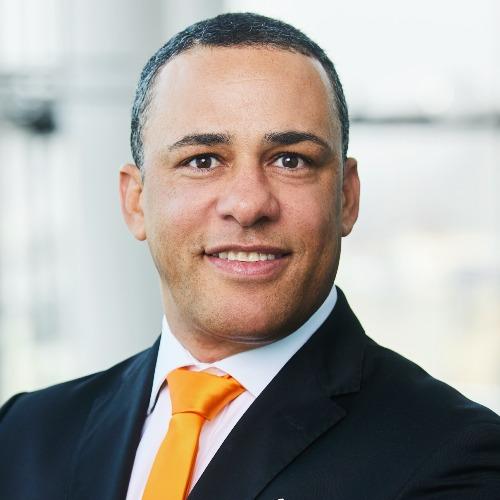Our services cover:
- Provide circular principal upskilling workshops
- Provide circular expert workshops (ISO 59000 circular economy)
- Attend PwCs center of circular economy excellence
How the circular economy can help you cut specific costs and achieve your climate goals

Your expert for questions
Emanuel Chibesakunda
Partner, Circular Economy, Sustainability Services at PwC Germany
Tel: +49 175 3516769
Email
Did you know that embracing the circular economy can cut your CO2 emissions by up to 45%?
Whenever your products are thrown away, valuable resources are lost. The circular economy offers a solution: instead of being thrown out, products are kept in use for as long as possible, then reused, refurbished and recycled. In short: they stay in circulation.
And you can profit from this! Embracing the circular economy and its innovative business models can help you cut costs, comply with regulations, reduce greenhouse gas emissions and protect the environment. With changes to the law and consumer habits, rethinking our economic system is becoming essential.
“The circular economy offers companies a chance to gain a competitive edge, tap new sources of income and improve their resilience against external forces. In short, the circular economy provides answers to some of the most pressing questions facing companies today.”
Our consulting services stretch all the way from strategy through to implementation: from analysing your field and developing scenarios and visions to integrating solutions into your operations.
Our team brings together experts from a variety of disciplines depending on the needs of each client project.
Our collaboration with external service providers creates varied and valuable opportunities to develop and implement circular economy strategies.
Do you want to tackle the greatest challenges of our time? Do you want to discover how to use circular strategies to improve your company’s profits and reputation? Do you want to find out where value is being lost and growth hindered in your company?
There are many different approaches to the circular economy, providing a solution to make your company more resilient and more sustainable. Not sure where to start? We’ll provide you with structured guidance for your circular economy transformation.
Our experts are here to help you on your journey towards circularity – from strategy and business model transformation all the way to reporting. We offer tailored support in the following eight areas:
How can you ensure that your employees are qualified for the circular economy?
Which regulations do you need to follow?
Where are you losing the most value at material and product level across your product life cycle?
How can you ensure that products you develop comply with regulations?
How can you make upstream and downstream supply chains circular?
How can you develop viable business models for the circular economy?
How can you create networks between relevant players and build sustainable business ecosystems?
How can taking steps towards the circular economy help to reshape your processes?
A holistic transformation to the circular economy considers existing and upcoming legal frameworks, international climate agreements, new customer demands and market initiatives. We use our comprehensive experience and industry know-how to help you with the transition to the circular economy – and to create a framework for this process, we’ve developed our Circular Infinity Loop.
PwC’s Circular Infinity Loop is designed to translate the latest insights on the biological and technological material cycles into action-oriented guidelines for designing circular products and services. We use these guidelines to develop ideas for circular services and product worlds, and to link design changes in manufacturing with innovative changes in how products are used. We push the boundaries of how we think about circularity, and open up new horizons for using it to develop profitable, future-proof business models.
80% of a product’s environmental impact is determined during its development, before it even reaches the production line. This makes it essential to consider circularity in the design phase.
One of the aims of the circular economy is to keep products in circulation for as long as possible. Accordingly, circular economy strategies aim to make it possible to repair and refurbish products and their components.
When products reach the end of their lives, they are dismantled into their components and the materials are recycled. This enables them to be used as raw materials for new products, keeping these materials in circulation.
The circular economy needs a change in how we think in society. Innovative business models and state-of-the-art technologies drive the circular economy, and will need to be constantly followed and developed even further.
Another goal of the circular economy is to help regenerate natural resources and minimise negative impacts to conserve the natural world for as long as possible.
We explore and analyse circular economy scenarios for your organisation.
Our Sustainable Innovation team is here to help you design and improve your internal processes and value chains – for a strong brand promise. We’ll integrate tailor-made circular solutions to realise your ambitious goals for both the environment and your business.
Companies in different industries have different practices when it comes to procurement, manufacturing, sale, use and disposal of their products. Looking elsewhere in your value chain can reveal new cross-sector approaches.
We’re here to help you realise these benefits by applying our expertise in the following fields, which are based on the German National Circular Economy Strategy (NKWS):
Our focus lies on circular buildings, sustainable building materials as well as reclaiming and efficient recycling construction waste.
Starting points for circularity
Reusing and recycling plastics and using secondary raw materials in the plastics industry are solutions that minimise the use of fossile resources and reduce the amount of waste generated.
Starting points for circularity
With the growth in regulations, companies need to increase transparency in their vehicle and battery value chains (e.g. by using digital battery passports).
Starting points for circularity
Maintenance, repairs and innovative business models can help reduce the huge amount of e-waste that we currently produce and keep the value of rare materials in the economy stable.
Starting points for circularity
Sustainable materials and innovative business models help ensure that clothes and textile products can remain in use for longer. This saves resources, minimises waste and has positive social impacts.
Starting points for circularity

